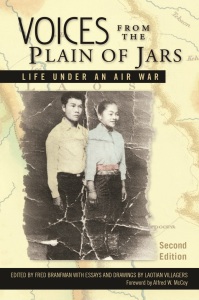 [In Laos,] where a right-wing government installed by the CIA faced a rebellion, one of the most beautiful areas in the world, the Plain of Jars, was being destroyed by bombing. This was not reported by the government or the press, but an American who lived in Laos, Fred Branfman, told the story in his book Voices from the Plain of Jars. —Howard Zinn
[In Laos,] where a right-wing government installed by the CIA faced a rebellion, one of the most beautiful areas in the world, the Plain of Jars, was being destroyed by bombing. This was not reported by the government or the press, but an American who lived in Laos, Fred Branfman, told the story in his book Voices from the Plain of Jars. —Howard Zinn
A classic. . . . No American should be able to read [this book] without weeping at his country’s arrogance. —Anthony Lewis, New York Times
Voices from the Plain of Jars — recently re-issued by the University of Wisconsin Press — first came out in 1972. Through poetry, songs, drawings, and other first-person testimony, Laotian villagers tell the story of the incessant U.S. bombing — a secret war brought to light by Fred Branfman, who collected these accounts.
In his foreword to this unique book, Alfred McCoy notes that, “By April 1973, the [U.S.] Air Force had dropped an estimated 2.1 million tons of bombs on Laos, which was the equivalent to the entire tonnage the United States dropped on industrialized Germany and Japan during the whole of World War II.”
This is an essential teaching resource to use in a unit about the “American War” in Southeast Asia. [Description by Rethinking Schools.]
ISBN: 9780299292249 | University of Wisconsin Press
Introduction
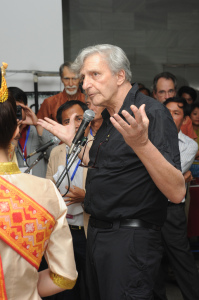
Fred Branfman at the launch of the new edition of “Voices from the Plain of Jars,” Nov. 8, 2010.
Here is the introduction to the new edition, as sent by Fred Branfman and with permission of the University of Wisconsin Press.
This is a new introduction to Voices From the Plain of Jars: Life Under An Air War, originally published in 1972, the only book to emerge from the Indochina war written from the perspective of its villagers. It is also the only book to describe life under the largest and most protracted bombing of civilian targets in history, one which left behind more unexploded cluster bomblets in Laos than in the rest of the world combined. These voices also represent those of civilians around the world who are now being subjected to automated war even as you read these words. The book is being re-issued today in conjunction with the November 2010 First Meeting of State Parties to the Convention on Cluster Munitions, held in Vientiane, Laos. The Convention is one of the first attempts in history to protect civilians from bombing during wartime and its aftermath. Much of the material below is drawn from the “Laos Automated War Archive” — 36 articles comprising the most comprehensive description of an air war yet compiled.
—————————————————————————————————
Around that village of mine were green and beautiful mountains, and the land and the fields my neighbors had sweated over and labored on since the time of my ancestors. My neighbors were all farmers, honest and hard-working. Our happiness was full and overflowing because we were content with our lives, even though we lived in the wilderness. —A 26-year-old nurse from the Plain of Jars, on life before the bombs
There wasn’t a night when we thought we’d live until morning, never a morning we thought we’d survive until night. Did our children cry? Oh, yes, and we did also. I just stayed in my cave. I didn’t see the sunlight for two years. What did I think about? Oh, I used to repeat, “Please don’t let the planes come, please don’t let the planes come, please don’t let the planes come.” —Refugee from the Plain of Jars, on life under the bombs
I awoke in Vientiane, Laos on a day in early September, 1969, with no idea that my life was about to change forever.
I had lived in a Lao village for the previous 2 1/2 years, spoke Laotian, and had finished my alternative to military service as an educational advisor with International Voluntary Services three months earlier. I had remained because I really liked Laos and Lao people and was at loose ends about what to do next.
My years in the village, which lacked running water and electricity though only 11 kilometers outside Vientiane, had led me to deeply appreciate Lao rice farmers. I knew them as real human beings, neither idealized nor romanticized them, and had certainly met some I disliked. But, on the whole, I had never met a group of people whom I liked and respected more. I found them kind, friendly, cheerful, decent, fun, honest, sincere and trustworthy. I appreciated how the villagers looked me in the eye, told the truth, and connected on a deep human level. There may be people as fine in this world, I used to tell my friends. But I could not imagine any finer.
I felt particularly close to Paw Thou Douang, the village elder in whose house I lived. He was a deeply devout Buddhist and lay leader of the Buddhist temple ten yards from our home. He was also a medic, farmer and, I discovered after the war ended, the local representative of the Pathet Lao. He was a cheerful, kind, wise, gentle, much loved man whom I deeply respected, and had become a kind of second father to me.
Laos was then divided into the pro-U.S. Royal Lao Government zone of some 2 million people where I lived, and the guerrilla Pathet Lao zone of some one million that was closed to westerners. I was staying that day downtown with my friend Tim Allman, a New York Times journalist, who asked me if I would interpret for him as he went to interview refugees from the Plain of Jars. The first residents of guerrilla zones ever to reach Vientiane, they were being housed at the That Louang pagoda in the center of the city.
I eagerly agreed. Although the Plain was only some 230 miles from Vientiane it might as well have been on the other side of the moon for all we knew of it. I was curious about life in Pathet Lao zones, and the rumors of U.S. bombing denied by the U.S. government but reported in Le Monde the previous spring.
THE FIRST VISIT: EARLY SEPTEMBER 1969
At that time my life was filled with great happiness, for the mountains and forests were beautiful: land, water, and climate were suitable for us. And there were many homes in our little village. —13-year-old boy, on life before the bombing
Tim hopped on the back of my motorcycle. We drove up to That Louang, and entered a large but sparsely furnished prayer shed the size of a football field, filled with hundreds of refugees spread out on the floor.
We picked one man at random, and began to interview him. When I asked him whether he had seen any bombing, his faced clouded over and he began to describe being bombed frequently for the previous five years. At one point he crouched down and did something that has been engraved in my memory forever. He draw an “L” in the dust, showing the shape of the shelter he had dug into the side of a mountain, where he had hidden by day for months on end, to escape the bombers that came every day and gradually demolished his entire village. “We lived like animals!” he said, explaining how he could only come out at night to try and do some farming, and find some food to keep himself and his family alive.
I was thunderstruck. Seeing this subsistence-level innocent Lao farmer describing how he hid like an animal for months on end from bombers sent from a rich, comfortable distant land to burn and destroy his fellow villagers, family members, livestock and home, without him even knowing who was bombing him or why, and against whom he had committed no offense whatsoever, seemed to me then — and has seemed to me ever since — among the ultimate evils, lack of humanity, and horrors that I could possibly imagine.
In shock, I then interviewed over a dozen refugees. Every one gave the same basic report. The bombing had begun in 1964, gradually intensified year by year until, starting in late 1968, they were bombed daily. Villager after villager described seeing relatives and friends burned and buried alive, their livestock killed, their homes and pagodas demolished, living in holes for months on end, and their intense pain at being forcibly removed from the villages of their ancestors to wind up as penniless refugees in Vientiane. The main victims of the bombing, every refugee explained, were civilians — particularly older people, mothers and children who had to remain near their villages to survive. The soldiers moved through the deeply carpeted forests of northern Laos, and were relatively unscathed by the bombing.
THE REFUGEE CAMPS: SEPTEMBER 1969 — FEBRUARY 1971
Travel between villages was easy because there were so many all close together. Boys and girls playing the flute and enjoying themselves in the village was easy. When it came time to work the fields, we went to work together. We shared the labor in a fulfilling way for us young people. When the field work was finished, we joined in the yearly festivities with the sounds of singing, dancing and laughter. —39-year-old farmer, on life before the bombing
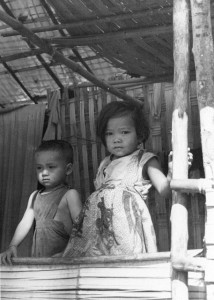
Nang Khamphounta, the mother of these children, described how their father, Thit Boun Thong, was killed by bombs from a T-28 aircraft in August, 1969. There were no soldiers around when the planes bombed.
I heard all of this with a slowly mounting and disbelieving horror, unable to take in all I was hearing from people who were just like those I had come to love in my village. I suppose if I had not been as close to the people of my village, if I had seen the Plain of Jars refugees only as nameless “bombing victims”, I might not have had such a strong reaction. But to me these fine, decent people whom I respected so much did have names and faces, and family members, and dreams — and at least as much right to them as did I or those who so cruelly snuffed them out without a thought. Realizing what was happening to these people I so admired felt unbearable.
It was only as I went back frequently to talk with the refugees over the next 15 months — and above all later read the drawings and essays that appear in this book — that I was able to absorb the full dimensions of who these people were, what they had been through, and its implications for humanity.
The refugees in That Louang were soon moved out to refugee camps around Vientiane, and over the next six months more were brought from the north and the numbers of refugees from the Plain grew to some 20,000 people.
During the following 15 months of interviewing the refugees, my first level of shock came from realizing that these people had been bombed for five years without the knowledge of most outsiders in the country, myself included. At that time the U.S. government denied that it was doing any bombing in Laos at all. And, unlike in South Vietnam, journalists were not permitted to go out on bombing runs. It seemed eerie and frightening that a handful of U.S. leaders had the power to so bomb so secretly.
I was deeply disturbed to learn how much unilateral power a handful of U.S. Executive Branch leaders had, both Democrats and Republicans, and their callousness in using it. I realized that the problem wasn’t that my leaders hated these Lao. They simply did not care. They conducted this mass murder not out of malice but sheer indifference to the existence of these innocent Lao rice-farmers.
I experienced even greater horror at seeing the physical effects of the bombing on the refugees. I interviewed 38-year-old Thao Vong, who had been blinded by an antipersonnel bomb attack in July 1967[1]. I saw a young boy missing a leg. I spoke with the father of 3-year-old Khamphong, one of six of his children who were hit by cluster bombs on February 28, 1969, and felt the pellets still in her body. I learned from Pha Sii how her daughter-in-law was killed in August 1969 shielding her year-old child with her body. I met a 35-year-old man from Ban Na Sou, whose father, mother, wife and three children were all killed in a July 15, 1967, bombing raid. I talked with Po Sing Som’s wife, who described how her husband, in his sixties, was killed by antipersonnel bombs in a September 16, 1968 raid that wounded her and also left pellets still visible in her body.
Two incidents stood out above all. One was receiving the striking wedding photo of Sao Doumma, a sweet-faced woman, who was killed in a bombing raid seven years later. It symbolized to me the deep humanity of the unseen and unknown victims of the bombing. (It was later to become the frontispiece of this book and a full-size version was displayed at many of my talks — and my wedding — upon returning to the U.S.) The second was meeting the mother of a 3-year-old girl who had been burned in her breast, stomach and vagina. I was devastated to return a week later and learn that the child had died.
Words cannot convey the pain I felt seeing the wounds of the survivors and hearing their stories of the painful death of their loved ones due to the bombing that continued week after week, month after month, for five and a half long years, longer than U.S. involvement in World War II.
I was especially shocked to learn that many of the people of the Plain of Jars had no idea who was bombing them or why. It was for them like the War of the Worlds science fiction movie in which unknown giant machines attacked them for reasons they did not understand. I had no real answer when refugees asked me, with genuine curiosity, “Why did they bomb us? Do you know?”
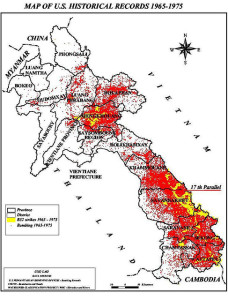
Map of Laos bombings.
I was also particularly struck by discovering something I had never even heard of before: cluster bombs. I first became aware of them when I noticed a yellow pineapple bomb being used as a lamp in one of their huts. The refugees said it was these bombs which had done them the most damage and which they most feared. Exploding over a wide area, they killed those who could not dive into their holes fast enough, particularly older people who were slower in running or children confused by the noise and smoke. They said people had also been murdered by stepping on unexploded bomblets even when the bombing was not occurring.
By far the deepest level of pain I experienced, however, came from the most disturbing realization of all: “My God! The bombing is still continuing!” The realization that there were at that very moment Lao people alive today who would be bombed to death tomorrow hit me like a hammer.
I am Jewish, and had been deeply moved when meeting Holocaust survivors some years earlier. In this situation, however, it felt as if I had learned what was occurring at Auschwitz while it was still going on. Without any conscious decision, I soon found myself committed to doing whatever I could to stop the bombing by trying to expose it to the world.
There were only a handful of reporters permanently stationed in Laos, and most major journalists came in from elsewhere to report for a week at a time. Over the next 15 months I wound up working for reporters from all of the major TV networks and many newspapers. From their perspective they were hiring an interpreter and fixer. From mine, I was trying to get the story of the bombing on media back in the U.S. I also took photos and tape-recorded conversations with the refugees and sent them to Senators Kennedy and Fulbright, escorted visiting peace activists like Noam Chomsky out to the camps, and briefed diplomats and Congressional aides. [Read about Chomsky and Branfman in Laos in Salon.]
During this period I became friendly with a Plain of Jars refugee my age named Ngeun. He stood out for his obvious intelligence, cheerfulness, warm-heartedness, self-confidence, honesty, and steadfastness. He became the closest friend I have ever had, and I learned that he had been a former soldier, cadre and medic for the Pathet Lao.
We were talking one day in the fall of 1970, and I casually said to him, “You know, Ngeun, it’s a pity these people can’t read and write. If they could, it would be interesting to see what they would say.” “Hwai!” he responded indignantly, “they can read and write better than you can!” “Really?” I said, shocked that I had so cavalierly assumed that they were illiterate. “Do you think you could ask them to write down what their life was like under the bombing?” He agreed and collected the essays and drawings that appear in this book. He did so at some risk, as he had to hide them under his shirt as he passed through police checkpoints.
THE U.S. AIR FORCE: SEPTEMBER 1969 — FEBRUARY 1971
I will tell about my past life in Xieng Khouang, an area with high mountains and scattered open plains. It is naturally beautiful because the climate is cool and misty. In the mornings, fog shrouds the mountain. In the evening, the rays of the sun silhouette the mountain in a most charming scene. And turning, you can see the water cascading from the top of a high mountain. —16-year-old student, on life before the bombing
My other reaction to discovering the bombing, however, was to try and understand how it had occurred. Learning of this mass murder had destroyed my moral universe, throwing into question my deepest assumptions about my leaders and humanity. It was obvious that the bombing of these people violated international law, and yet the Nuremberg Principles, the Geneva Conventions and the U.N. Charter might as well have not existed.
Many of my deepest beliefs, which I had taken for granted since childhood, had suddenly become null and void. I learned in those camps that crime does pay, truth and justice do not eventually triumph, and goodness and innocence are not rewarded. I soon learned that U.S. Executive Branch leaders had unilaterally bombed Laos without even informing let alone seeking permission from Congress. This clearly demonstrated that my country was undemocratic at home and my leaders a force for much evil abroad.
I found myself wondering what it said about humanity that the richest and most comfortable of the species had spent five years[2] savagely murdering some of the poorest, that they would deploy the world’s most sophisticated technology against villages that lacked even running water and electricity. How could they be so cruel, merciless and pitiless to such kind, sweet, gentle people who posed no real threat to their interests? What did it mean that they were so indifferent to human suffering?
I was particularly haunted by this question: If innocent, kind, gentle Lao people could be slaughtered this way, who among us was safe? If the Lao could not be protected from this senseless savagery, who could be?
I can still remember those first few days standing in the prayer shed at That Louang, and feeling overwhelmed by both these and more immediate questions. Who had ordered this bombing? Who was conducting it? Why were they using these kinds of weapons? Where were the planes coming from? What on earth was going on? I literally had no idea.
A Peace Corps volunteer friend of mine named Charlie lived in nearby Udorn, Thailand, the site of a major U.S. Air Force base bombing Laos. During a visit to Vientiane he offered to introduce me to some Air Force personnel who were against the war. I went to Udorn and first began to learn about the giant machine of 50,000 airmen involved in bombing Laos, from bases in Thailand and South Vietnam, and aircraft carriers in the Gulf of Tonkin. The men I talked to, a small minority, were against the bombing because they knew their leaders were lying when they denied they were bombing Laos. Many happened to load cluster munitions onto airplanes, and were horrified to learn what they were doing to civilians. A captain in charge of the ordnance dump at Udorn told me that 75-80% of the ordnance on hand were antipersonnel bombs. A sergeant explained how just one sortie carried 1,000 clusters, which sent 250,000 steel pellets over an area the size of four football fields. (I later learned that more than 580,000 bombing sorties total had been flown over Laos.)
In the months and years to come I visited more airbases in Thailand and interviewed pilots at Danang Air Force base in South Vietnam. I also met Jerry Brown, a former U.S. Air force captain who had clandestinely selected targets out of the U.S. Embassy in Vientiane. He was then working in advertising in Bangkok, and agreed to a long series of interviews — primarily because he had been upset at how the C.I.A had taken over the selection of targeting and deliberately targeted villages. He made it clear that the U.S. Embassy, Air Force and C.I.A knew full well that civilian targets were being bombed.
One of the most shattering revelations about the bombing was discovering why it had so vastly increased in 1969, as described by the refugees. I learned that after President Lyndon Johnson had declared a bombing halt over North Vietnam in November 1968, he had simply diverted the planes into northern Laos. There was no military reason for doing so. It was simply because, as U.S. Deputy Chief of Mission Monteagle Stearns testified to the U.S. Senate Committee on Foreign Relations in October 1969, “Well, we had all those planes sitting around and couldn’t just let them stay there with nothing to do.” (p. 484)
I shuddered at learning why the people of the Plain of Jars had been subjected to such hideous suffering, at realizing firsthand the meaning of the philosopher Hannah Arendt’s famous description of the Nazi Adolf Eichmann. This “banality of evil” was one of the most striking — and frightening — features of the bombing.
WASHINGTON, D.C.: FEBRUARY 1971 — APRIL 1975
The village in which I was born, so pleasing to me, had a cool, fresh climate and rich mountains and forests. There was also much land for rice fields and raising livestock. For many years, I raised cows and buffalo, as my parents had taught me to do. I saw this as very beneficial and enjoyable for someone living in the countryside, for a farmer who inhabited the mountains and the forests.” —17-year-old boy, on life before the bombing
In February 1971, I was singled out for expulsion by the Royal Lao Government and returned to Washington, D.C. to oppose the bombing — ironically at the height of concern about the war in Laos due to the South Vietnamese invasion of southern Laos then under way. I directed two peace groups over the next four years — Project Air War and the Indochina Resource Center — which became major sources of information about the war for Congress, the media and peace groups throughout the nation.
I had purchased an antipersonnel bomb/lamp from one of the refugees, and frequently displayed it when speaking or making media appearances back in the U.S. (I could actually pass airport inspection with an antipersonnel bomb in my suitcase in those innocent pre-9/11 days!) Audiences were uniformly horrified when I explained how these weapons had mainly wound up injuring innocent Lao villagers, and how they had been fiendishly expanded from being mere steel pellets to flechette arrows designed to do more damage when being extracted then going in, and thence to plastic pellets invisible to X-rays.
My antipersonnel bomb became both substance and symbol of what the bombing was all about. Nothing did more real-world damage to civilians. And nothing more symbolized the cruelty of the air war for innocent human beings, whatever its stated purpose.
We published several articles on antipersonnel weaponry during this period, in the Washington Post, Newsday and peace publications around the country. We also published a booklet called They Survived, consisting of the photos and stories of bombing victims, and The Era of The Blue Machine in the Washington Monthly, one of the fullest description of the air war ever published.
I briefed Congressman Pete McClosky in some detail about the bombing, including information on where the refugee camps were located, in preparation for his April 1971 visit to Laos. Upon his return he generated enormous publicity, charging that the U.S. government was lying when it denied it was bombing civilians.
Senator Kennedy’s staff then invited me to attend an April 22, 1971, hearing on the Laos bombing at which U.S. Ambassador William Sullivan would testify, and said the Senator would call on me from the audience. The giant hearing room was packed. I sat in the audience, remembering the hundreds of refugees I had interviewed who had described losing loved ones, hiding in terror from the bombs, seeing their villages destroyed. When I heard Ambassador Sullivan testify that “the policy of the U.S. is deliberately to avoid hitting inhabited villages,” a nauseating shock passed through my body.
Kennedy then did call on me. I stood up, described interviewing over 1,000 refugees who all said their villages had been bombed, said that “the evidence is clear that the U.S. is conducting the most protracted bombing of civilian targets in history,” and urged Kennedy to take action. Sullivan then again denied the bombing of civilians. Kennedy simply responded to Sullivan, “I don’t believe you,” and the hearing ended. I left with a sick feeling, knowing that the bombing was continuing to kill the innocent hour after hour, day after day, month after month, year after year. (In the end the bombing of Laos continued for nearly two more years after this hearing.)
While the exchange with Sullivan made the NBC Nightly News and generated other media coverage, the overall — and devastating — lesson was clear. Senator Kennedy’s own staff had published a report seven months earlier stating that “the United States has undertaken a large-scale air war over Laos to destroy the physical and social infrastructure of Pathet Lao areas. The bombing has taken and is taking a heavy toll among civilians.” The Senator clearly knew that a U.S. Executive Branch representative had looked him in the face and lied about U.S. responsibility for mass murder, and was lying to Congress and the American people. But he took no action. Nothing brought home to me more that the U.S. Executive Branch was an all-powerful authoritarian institution when it came to automated war, with Congress playing virtually no meaningful role at all. I had learned firsthand that, when it came to Executive war-making in Laos, the U.S. Constitution had as little significance as international law.
When I had returned to Washington, D.C. in February 1971, I had brought the essays and drawings by the refugees with me. I did not read Lao, however, and had no idea of their significance. They sat in my closet for six months until I contacted a Lao student studying in Montreal named Hiem Phommachanh, who agreed to help me translate them into English. Hiem, now Deputy Foreign Minister of the Lao PDR, worked side by side with me for several weeks. He would translate the essays aloud from Lao into French, and I would write them down in English.
It was one of the most touching and deeply spiritual experiences of my life. We were both moved beyond words by what were reading. And we — a Lao and an American working in a small room while countless more Lao continued to be killed by countless more American bombing raids — experienced our common humanity on the deepest possible level.
During my time in Laos I had primarily seen the refugees from the Plain of Jars as victims of war, people I liked but also pitied. I had focused on their suffering.
Their essays and drawings, however, led me to understand their poetic souls, deep human feeling, appreciation of nature, warm personal relationships, love of family and community, and how much more I had to learn from them than they from me. It was only through reading this material that I began to fully appreciate the contrast between the deep humanity of their culture and the nonhumanity of so much of my own.
The translated essays and drawings had some impact. The New York Times devoted an entire op-ed page to them, we displayed them on the Walter Cronkite CBS Evening News, Bill Moyers Reports, and many other TV shows, and they were widely distributed by peace groups around the nation.
Harper and Row published them in the summer of 1972 as a book titled Voices From the Plain of Jars: Life Under An Air War, and Time Magazine devoted a full page to reviewing it, commenting that “the `voices’ recorded have rarely been heard. They come from the ground beneath the air war.”
A New York Times book reviewer wrote that the book “strikes at our consciousness and conscience . . . Not since the thirties when Helen Snow in Red Dust turned in on the population surrounding Mao Tse-tung in the caves of Yenan, have Asian victims spoken to us so directly.”
A review in the New York Review of Books stated that “in this small, shattering book we hearmdash;as we are so rarely able to do — the voices of Asian peasants describing what we can barely begin to imagine.”
Noam Chomsky wrote in the Saturday Review of Literature that the “work is profoundly subversive, not only because (it) has, more than anyone else, exposed the facts, but more significantly because (it) has insisted the natives are human.”
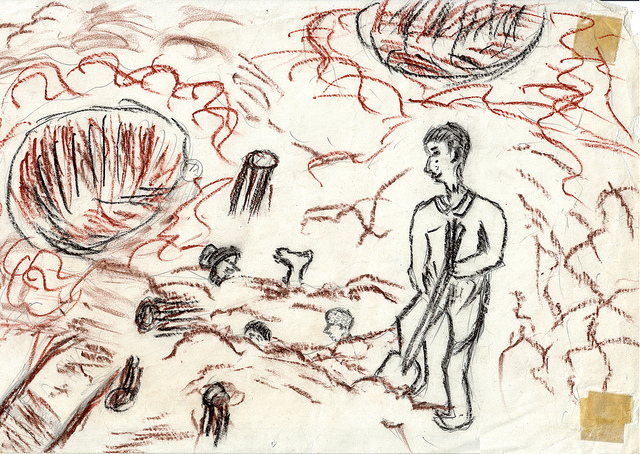
Illustration by a bombing survivor, 1971: “In the earlier times of my village we had good fortune and there was nothing to cause us fear or danger in the lives of the Laotian rice farmer. In our region like in other regions the same. But in 1965, the airplanes began to come drop bombs on the people of Xieng Khouang until it caused deaths and injuries to the people. As in this picture, there were people who died in the holes. There were many people who couldn’t get out. All that could be seen were heads, legs, and hands only. Then there was a man who went to dig them out because his child and wife were buried inside.”
New York Times columnist Anthony Lewis wrote on July 9, 1973, that “the most appalling episode of lawless cruelty in American history (is) the bombing of Laos. The human results of being the most heavily bombed country in the history of the world were expectably pitiful. They are described without rancor — almost unbearably so — in a small book that will go down as a classic. It is Voices From the Plain of Jars, in which the villagers of Laos themselves describe what the bombers did to their civilization. No American should be able to read that book without weeping at his country’s arrogance.”
The surreal contrast I had experienced in Laos while shuttling between Lao refugee camps and U.S. airbases was intensified during my years in Washington. Each morning, while shaving, I would look at my eyes in the mirror and remember the sad, soulful, gentle eyes of the people from the Plain of Jars, and what the war had looked like from the “bottom up.” Each day I would then spend my time discussing the bombing from the “top down,” mostly fruitlessly trying to convince lawmakers to act to stop it, journalists to write about it, or audiences to work against it.
The fact that innocent villagers were dying every hour of every day was never out of my consciousness during that period. And it was the surreal disconnect between those ongoing deaths in Indochina and the indifference to them in America that I most remember from those years:
- Villagers dying as I debated a U.S. Air Force officer in Senator Clifford Case’s office who, shocked at my saying that civilians were being bombed, responded by assuring the Senator with clearly earnest sincerity that “the United States Air Force never bombs people. We only strike enemy combatants.” When I explained this simply wasn’t true, he looked at me not with anger but unfeigned amazement that I would make such a statement, as if I had come from another planet. Which I suppose I had.
- Villagers dying as I read the following statement by Major General Robert Ginsburg, the U.S. Air Force chief of public affairs: “I don’t understand why people are so upset about antipersonnel bombs because they can’t destroy a truck or bridge and only kill people. They are antipersonnel bombs. They are not designed to destroy structures or vehicles.”
- Villagers dying as I was screamed at by the Speaker of the House to “keep those things in your briefcase!” as I began to pull out some drawings, because he feared I would show him “atrocity photos” of children whose deaths he had earlier funded.
- Villagers dying as my Congressman pulled his chair close to mine as I lobbied him to stop the bombing, and whispered in my ear that I shouldn’t go too far because otherwise the Pentagon would stage a military coup.
- Villagers dying as a CBS Evening News producer interrupted me, when I began to describe the bombing, so as to proudly show me the antipersonnel flechettes he was using as thumbtacks on his bulletin board.
- Villagers dying as a Los Angeles TV station accompanied the display of the drawings with the instrumental version of the 1940s big-band song “Sentimental Journey,” rather than allowing me to read the captions as I normally did.
- Villagers dying as I showed a photo on TV of a teenager blinded by Richard Nixon’s Christmas 1972 bombing raids whom I had recently interviewed in a Hanoi hospital, and was told by Nixon biographer Victor Lasky that “I was just talking with the president this morning, and can assure you that he is just as concerned about the bombing victims as are you.”
- Villagers dying as the head of the Air Force Pacific Command, drunk out of his mind, slurredly informed me that he too wanted to end the war: “I’ve always been one of those get in and get out kind of guys, know what I mean?”
- Villagers dying as a TV network State Department reporter, who I had taken to the camps and knew firsthand of Secretary of State Henry Kissinger’s mass murder of civilians on the Plain of Jars, angrily told me, “I’ll have you know that Dr. Kissinger is a close personal friend of mine!” in response to my complaining about the media’s disinterest in the bombing and Kissinger’s role in it. (When phone logs of him flattering Kissinger were recently revealed he explained to the New York. Times: “Am I shocked by the notion that people were sucking up to a very powerful official they relied on for information? . . . Frankly, no.”)
- Villagers dying as I saw my antipersonnel bomb held up by a decent U.S. Senator then running for president at a giant campaign rally , and then saw him suffer a massive defeat by Richard Nixon a week later.
- Villagers dying as I saw the architect of the mass murder of the people of the Plain of Jars not only go unpunished but win a Nobel Peace Prize and become the toast of American high society.
NONHUMANITY ABOVE, HUMANITY BELOW
In my family there were 13 people — each one happy and content because the area was so bountiful and beautiful. In the evening, one could see the animals returning to their pens in a great unbroken herd after a day of searching for grass. When I would see that, I would feel content because these animals were my heart. If I needed money, I could sell them or some of my other property. — 51-year-old farmer, on life before the bombing
As the years have passed, it is this contrast between what I have come to regard as the “nonhumanity” of those conducting the bombing, and the profound, rich and moving humanity of those below, that I have found most significant — not only for what happened on the Plain of Jars 40 years ago but for a 21st century that will be increasingly marked by automated war. Much of war-making has of course historically been intensely “inhuman” conflict between enemies who hate each other, whether Nazis and Russians, Hindus and Muslims, Serbs and Bosnians, Palestinians, and Israelis.
American leaders, however, had nothing against the one million Lao upon whom they dropped 2 million tons of bombs, as much as was dropped on hundreds of millions through Europe and the entire Pacific Theater in World War II. They simply ignored their existence. The bombing of the Plain of Jars marked the fulfillment of a prediction previously only imagined in fiction, as when Orwell in 1984 described how “war involves very small numbers of people, mostly highly trained specialists. The fighting takes place on the vague frontiers whose whereabouts the average man can only guess at.”
The contrast!
Above, for years on end, the most sophisticated killing machines ever invented hovered over subsistence-level villages, looking for any sign of human life so as to eliminate it. There were O1E, 02, and OV10 spotter planes at 2,000 feet; AlE, A26, and T28 prop bombers, AC47, AC54, AC119, and AC130 gunships, rescue helicopters at 5,000 feet; F4, F100, F105, F47, and B57 jet bombers, jet reconnaissance, C47 and EC119 electronic aircraft at 10,000 feet; KC135 supertankers at 20,000; B52s at 30,000; EC130 command and control aircraft at 35,000; and SR71 photo recon aircraft at 70,000 feet.
Below, as a 30-year-old Lao woman described, “I saw my cousin die in the field of death. My heart was most disturbed and my voice called out loudly as I ran to the houses. Thus, I saw life and death for the people on account of the war of many airplanes in the region of Xieng Khouang. Until there were no houses at all. And the cows and buffalo were dead. Until everything was leveled and you could see only the red, red ground. I think of this time and still I am afraid.”
Above, pilots dropped the most exotic weapons ever invented on these villages: napalm, white phosphorous, fragmentation bombs, standard and delayed-action 250-, 500-, 1,000-, 2,000-, and 7,500-pound high-explosive bombs, horizontally exploding ball bearing “pineapple” cluster bombs, diagonally exploding ball bearing “guava” cluster bombs, steel-arrowed flechette antipersonnel bombs meant to prevent doctors from operating because they did more damage coming out than going in, antipersonnel bombs bearing fiberglass pellets which could not be X-rayed, laser and teleguided missiles.
Below, a 28-year-old Lao farmer wrote, “Because these airplanes dropped bombs on the village without stopping, the people had no place to go to escape. They had never before experienced anything like this. It caused parents to be taken in death from their children, and children to be taken in death from their parents, in great numbers, causing the people’s tears to flow.”
Above, pilots robotically reported their coordinates and payloads to the command and control ships, waiting for instructions to unload.
Below, a 30-year-old Lao woman: “At that time, our lives became like those of animals desperately trying to escape their hunters. Our lives were confided to the Lord Buddha. No matter when, all we did was to pray to the Lord to save our lives. We didn’t know how long we would stay alive. When looking at the faces of my children who were losing the so very precious happiness of childhood, as each and every day we would seek escape somewhere in the forest, I would grow increasingly miserable because of the war and hate it more and more.”
Above, pilots returning to Thailand with unexploded bombs from North Vietnam casually chose to dump them on Lao villages rather than in the forest.
Below, a 26-year-old Lao nurse wrote, “we who were young took our sweat and our strength, which should have been spent raising food in the rice fields and forests to sustain our lives, and squandered it digging holes to protect ourselves. For many days and nights, having enough food to survive on became a gigantic problem which pressed upon our hearts. The fields, paddy and seedbeds all became bomb craters. All that remained for our people were sad faces, and tired and weak hearts, disgusted with hating the war, which was like a large stone weighing upon us. We could not understand or imagine why something like this could happen.”
Above, the split-second push of a button, and pilots then returning to their bases for a cold one, nap and night carousing with prostitutes in the giant bars surrounding the airbases.
Below, a lifetime of pain, as described by a 39-year-old farmer: “They dropped eight napalm bombs, the fire from which burned all my things, 16 buildings along with all our possessions inside, as well as maiming our animals. Some people who didn’t reach the jungle in time were struck and fell, dying most pitifully. By the time the fire died down it was dark. Everyone came out of hiding to look at the ashes of their houses. Even the rice was all burnt. Everyone cried at once — loudly and agitatedly. Some families had been wounded.”
THE AFTERMATH
The mountains and forests are filled with so many useful kinds of birds and animals. Neither paddy farming nor building homes was difficult, for all the villagers would help one another with the work, and it was extremely gay and happy for us young people. That place, though it was very rural, and composed only of forests and fields, was perfect for me. —13-year-old boy, on life before the bombing
When the war ended, I entered domestic politics. I wanted to work to elect a new generation of decent leaders rather than spend the rest of my life simply opposing the latest crimes by the architects of mass murder we call “President” or “Secretary of State.” Although I never forgot the refugees from the Plain of Jars, I assumed that their suffering from the bombing had ended.
I was thus shocked to learn from reports by Jacqui Chagnon and Roger Rumpf of the Quakers, and Titus Peachey of the Mennonite Central Committee, who worked in Laos after 1975, that there were still tens of millions of unexploded cluster bombs that were still murdering and maiming countless civilians.
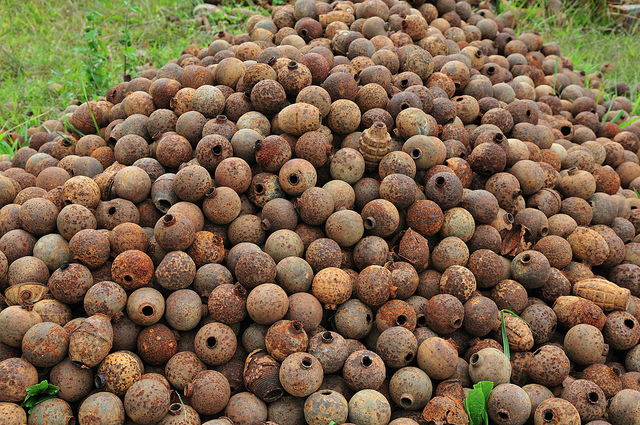
A pile of unexploded ordnance (UXO) that have been cleared. More than one third of the land in Laos is contaminated with UXO.
I observed this directly when I visited the Plain of Jars for the first time in 1993, with my old friend Ngeun. As people described to me losing friends and relatives from postwar cluster bomb explosions I saw with my own eyes the monstrous hellscape in which children thought it normal to grow up amidst hidden bombs that could destroy their lives in an instant.
And I discovered a new dimension of “nonhumanity.” U.S. leaders had spent over $10 billion on bombing Laos but had contributed virtually nothing to clean up the unexploded cluster bomblets they had left there — even as they were spending tens of millions to look for the bones of U.S. pilots killed while bombing Laos. (The U.S. spent just $5 million on UXO cleanup in Laos for all of fiscal year 2010 — equivalent to what it spent on just eight hours of bombing during the Indochina war.)[3]
I also talked with a 50-year-old farmer who had survived the bombing, been evacuated, and returned after the war ended. I knew the importance of water buffalo for plowing their fields, and asked him how many he had. “Eight,” he said. “Great!” I said. “Not so great,” he responded, “we had 100 head before the bombing.” I realized with a shock what this meant: if he was lucky he might some decades from now be back to where he had been 50 years earlier.
On my last day on the plain I stayed in a hotel overlooking it. I was on a spiritual journey at that point, seeking to achieve some kind of internal peace about what has occurred on the Plain of Jars. I wrote an article that ended with these words:
No people had ever escaped the fate of the Plain of Jars. It had risen, died, and been reborn again. None escape such cycles, perhaps not even those who had destroyed the plain and did not care to remember let alone do anything about it. A law of life beyond human purpose or understanding. So deeply lawful. So deeply comforting. So deeply peaceful.
Until you remembered her eyes.
What a beautiful human being, that lovely Vietnamese woman who sold goods in the market on the Plain of Jars. As the Plain is different from most places, this woman was different from most of the others. She’s a mother, a shopkeeper, a wife. But unlike most of her compatriots back in 1969, she had remained. Somehow, by hiding in the forest with her many children, her husband recently dead, she had managed to avoid the Hmong soldiers and did not have to leave the place of her birth.
She had remained. Up there. What was it like? “We lived like animals,” she said. I don’t remember now the details that followed: the exact number of children, those who had died, those who had lived. And what she had had to do to survive.
But I do remember her eyes. So beautiful. So sad. So tired. With a hint of something else. Something lost. Things had gone wrong: dreadfully, terribly, irremediably wrong. The years had passed. Nothing but ghosts now. And yet it wasn’t all right, not really. Most of the outer pieces had been put back together. Few visible scars. A largish shop in the market. Enough to eat. A home. Enough to make a case for the lawfulness of things.
But look into her eyes and it was clear there was something more to the story. Or something less. Something not quite right.
Something missing.
Over the next decade, I gradually became increasingly depressed about the bombing and, by 2003, had reached one of my lowest points since discovering it. I despaired to realize that those who had destroyed the plain had gotten away with it, thus freeing them to continue inflicting similar suffering elsewhere. But what somehow disturbed me most was realizing that this suffering had been almost entirely ignored, that it was as if it had never happened. It really was possible for a small group of leaders to wipe an entire foreign civilization off the face of the earth, and to then walk away leaving tens of millions of unexploded bombs to torment their descendants for decades to come, with the world outside neither knowing nor caring. I shuddered at the implications of this for the future of the species.
But then something remarkable happened. I received an email from a young Lao-American woman named Channapha Khamvongsa who had come across, by accident, some of the original drawings. Astounded that as a Lao she had known nothing of the bombing, and deeply moved by the suffering depicted in the drawings, she had decided to form an organization called Legacies of War to seek to educate the public and Congress about the need to clean up the unexploded ordinance and to promote, in her words, “history, healing and hope.”
Channapha used her first grant to digitize the drawings, both to preserve them and to assist in their wider use. She created a traveling exhibit featuring the drawings, set up an impressive public education effort out of Washington, and became a leader in pushing for more U.S. funding for UXO cleanup. It seemed almost a miracle that Channapha, and her group, existed.
THE CONVENTION ON CLUSTER MUNITIONS
A life whose only value was death, as every day and every night the planes came to drop bombs on us. We lived in holes to protect our lives. This kind of bomb would explode in the air and was much more dangerous than other ones [emphasis added]. —33-year-old Lao woman, Plain of Jars bombing survivor, describing a cluster bomb
I was further encouraged when I learned of the work to create a Convention on Cluster Munitions. From the perspective of what had occurred on the Plain of Jars it was clearly both of enormous immediate importance and a symbol of something even more significant.
If the Convention had been in force in the 1960s, many thousands of Lao people who died from cluster bomb explosions, and their descendants, would be alive today. The implementation of the treaty will save tens of thousands of innocent lives in the years to come.
And the Convention also brought hope that additional funding might become available to decontaminate the land of Laos, clearly the world’s top priority for cluster munitions cleanup. Well over 50% of all worldwide unexploded cluster submunitions lie on Lao territory. According to official figures, upward of 270 million bomblets were dropped, more than twice as many as the 113 million dropped on Vietnam and Cambodia combined, and more than five times those dropped on Iraq by U.S.-led coalition forces in 1991 and 2003. Laos today has some 80 million unexploded bomblets, more than the rest of the world combined.[4]
Lao officials estimate it could take hundreds of years to clean up existing cluster munitions at the current rate, which has seen only 0.28% of the total contaminated area cleared in the past 14 years.[5] If the Convention is to have any real meaning in the real world it will clearly see its signers encourage the U.S. to vastly increase its effort to clean up Laos, and to contribute to doing so themselves.
The U.S. bombing and its deadly legacy of cluster bombs has tormented and tortured the innocent people of Laos for nearly 50 years now. During the war it murdered and maimed them, destroyed their livestock and homes, forced them to live like animals in caves and holes, and turned many into homeless refugees. After the war, unexploded cluster bombs have killed and wounded tens of thousands more, denied them access to farmland they need to survive, and deprived their children of normal lives. And many are still poorer today than they were in 1964 before the bombing began. If there is any justice in this world, the international community will at least now find a way to clean up the unexploded ordnance still destroying the lives of the innocent, and offer assistance to the victims.
But the Convention is also a creative approach to a broader issue: the urgent need to protect all civilians in a time of war, especially from automated war. International humanitarian law — the law of war — largely focuses on two key issues: (1) preventing “aggressive war”; and (2) protecting civilians once armed conflict has begun.
However one feels about the first in regard to Laos, what happened on the Plain of Jars clearly proves that international law does not protect civilians during armed conflicts involving automated war-making.
From this perspective, the Convention on Cluster Munitions marks a tremendously important and visionary first step toward devising ways to protect civilians in what is certain to be a 21st century increasingly marked by automated war.
In a nonhuman age, the Convention thus represents far more than a treaty banning a specific weapon, however significant. It is, above all, a statement that civilian lives matter and that eliminating them is unacceptable to anyone who values human life.
The Convention is, in short, a cry for humanity.
CONCLUSION
Why then don’t we people love one another? Why don’t we live together in equality? Why don’t we build happiness and progress together? In reality, whatever happens, it is only the innocent who suffer. And as for the others, do they know all the unimaginable things happening in this war? Do they? —30-year-old Lao woman, a survivor of five years of U.S. bombing of the Plain of Jars, 1964-69
In all our years, we had known no more than the word “airplane.” We were all heavy hearted and mournful almost to the point of losing our minds. The other villagers and I got together to consider this thing. We hadn’t done anything, nor harmed anyone. We had raised our crops, celebrated the festivals and maintained our homes for many years. Why did the planes drop bombs on us, impoverishing us this way? —39-year-old farmer
And so too are these voices from the Plain of Jars.
I have never been able to read these essays without feeling like weeping. But I today hear their cry for humanity far more urgently than at any time since I saw the first refugee draw that “L” on the floor of the That Louang prayer shed.
I am not the first western volunteer in a Third World country to have learned more from local residents than did they from me. But what most strikes me today how the vision of human life presented by the people of the Plain of Jars has become key not only to individual satisfaction but the survival of our entire civilization in an age of catastrophic climate change.
They describe a way of life that values love of nature, camaraderie with friends, spiritual experience, building a family, and lovingly raising children over the pursuit of material possessions and wealth. If our climate scientists are correct that we are on the way to destroying human civilization as we know it in our children’s lifetimes, it may well be that our ability to learn how to live from the people of the Plain will determine whether our own children live or die. They led clean and simple lives. Only as we too learn to do so is our species likely to survive.
These voices from the Plain of Jars also offer us the clearest possible warnings about the dangers of runaway technology, whatever the original intentions of those deploying them. In an age of increasing automated war and nuclear proliferation, we can learn much from these voices, which teach us that the innocent really can suffer horribly from technologies that take on a life of their own, and that none of us are truly safe until the nonhuman mentality behind what occurred on the Plain is successfully challenged. If innocent pre-industrial subsistence-level rice farmers in a distant land who wished only to be left alone to till their crops and raise their families are not safe from the ravages of modern technologies, who among us are?
And these voices provide the clearest possible warning about the new challenges posed by a new age of “nonhumanity.” It was possible to mobilize against such “inhuman” leaders of the past as a clearly mad and violent Hitler. It is far more difficult, however, to organize against personally relatively decent and sane leaders who today commit mass murder through automated war of which the outside world is largely unaware.
The Convention and these voices thus merge into a single and all-important cry: Humanity matters, and preserving it must be our top priority.
If we listen to these voices, in other words, they can confirm our own humanity as well as that of the people of the Plain of Jars.
We cannot right past wrongs, as a 26-year-old nurse wrote four decades ago: “The past has melted away. Our lives have passed like a dream. There is nothing which can make up for the sorrow.”
But though we cannot make right this nonhuman past, hearing — and heeding — these voices today can inspire us to create a more human future. In a century marked by climate change, nuclear proliferation, and automated war, we have no higher calling — and need — than to do so.
Footnotes
[1] The Convention on Cluster Munitions covers unexploded bomblets which still remain in the ground and threaten civilians. The term “antipersonnel bombs” refers both to these cluster munitions and bombs designed only to kill and wound human beings at the time of use, such as flechette and fiberglass bombs, as well as cluster munitions that leave behind duds that fail to detonate and remain a threat beyond their immediate use. [2] The Plain of Jars was bombed from May 1964 until the summer of 1969; Laos as a whole was bombed for 9 years, from the spring of 1964 until the spring of 1973. [3] “over $10 billion on bombing Laos”: This estimate is based on figures found in “Indochina War Statistics – Dollars and Deaths, Congressional Record, May 14, 1975; and U.S. Defense Secretary Robert McNamara’s statement that each fighter jet sortie cost $20,000 in 1967 (please see Document 118, “New York Times Pentagon Papers”). Since 580,944 sorties were flown against Laos, that would put the cost of the air war at $11.6 billion (the actual figure is probably higher, because 39,206 of these sorties were by B52s, which presumably cost more than $20,000 per fighter jet sortie). 29.8% of the overall U.S. tonnage dropped on Indochina was dropped on Laos. 29.8% of the overall $31.7 billion cost of the air war, as estimated on page 14,264 of the Congressional Record entry cited above, comes to $9.5 billion. [4] Please see “Timeline of Cluster Munitions Use.” Also, “The Unexploded Ordnance (UXO) Problem and Operational Progress in the Lao PDR,” a fact sheet published by the National Regulatory Authority for UXO/Mine Action in the Lao PDR. [5] “Laos Unable To Clear UXO Within Ten Years- Official,” Vientiane Times, July 23, 2010.Images: From the Legacies of War Flickr albums

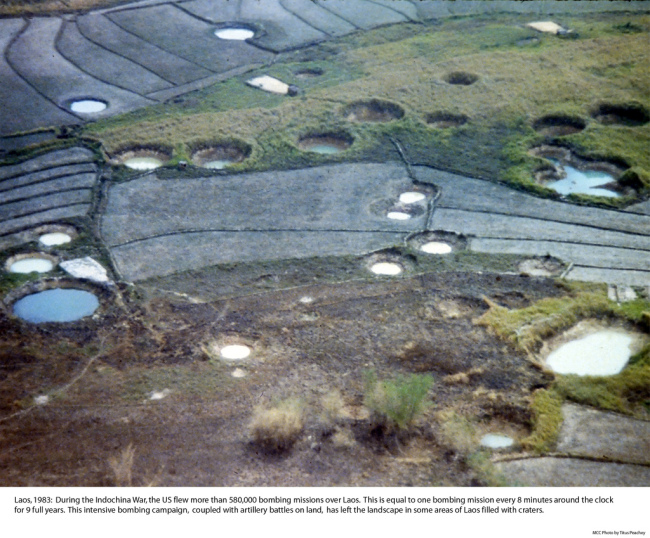
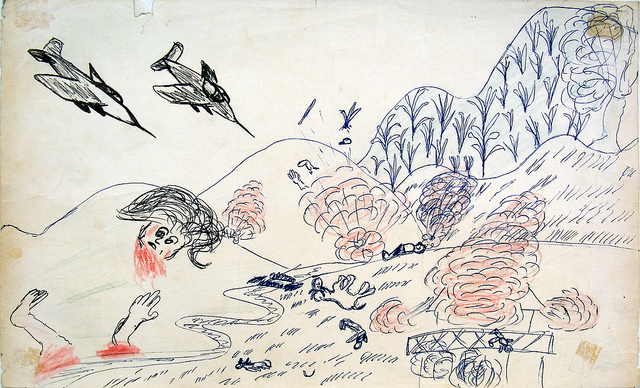
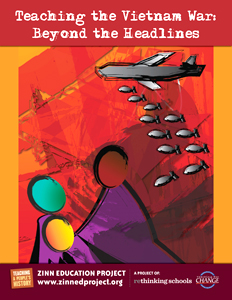
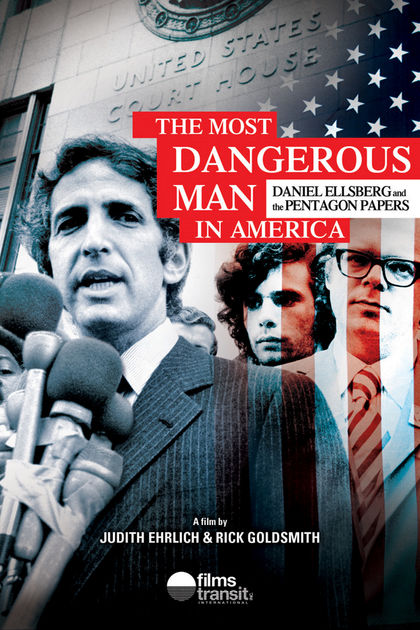






Born in 1951, this is my coming of age era. I opposed thw war in my teens and twenties and was vilified for “not supporting our troups.” Of course I supported the troups! Two “boys” I went to high school with died in this war and several others came home but were broken in spirit.
As bad as I knew it was for the civilians, victims of our senseless invasion, I did not know of the Plain of Jars. I stopped reading about the “war” of my generation some years ago, feeling frustration and depression that seemed to serve no useful purpose. I am so glad I read this. We must try to make a difference starting now, with the upcoming presidential election and seats to be filled in Congress. Apparently these offices were bypassed during this pathetic time in history. We know more now and I have to believe we can demand accountability from those making cavalier decisions about killing innocent citizens. It seems those in office that oppose a woman’s right to terminate a pregnancy are the very ones anxious to wage war on people with families who love and are loved and have a right to live their lives undisturbed.